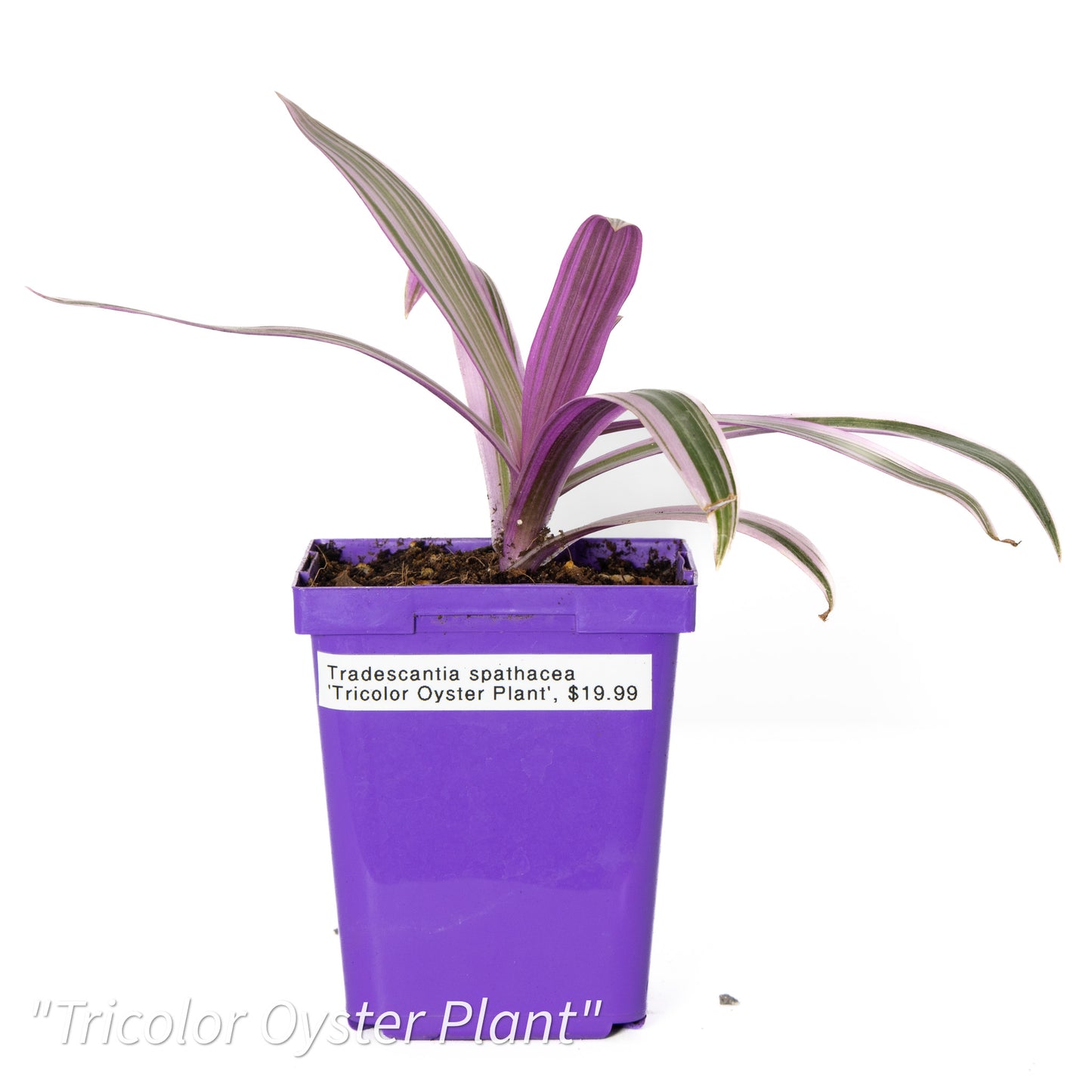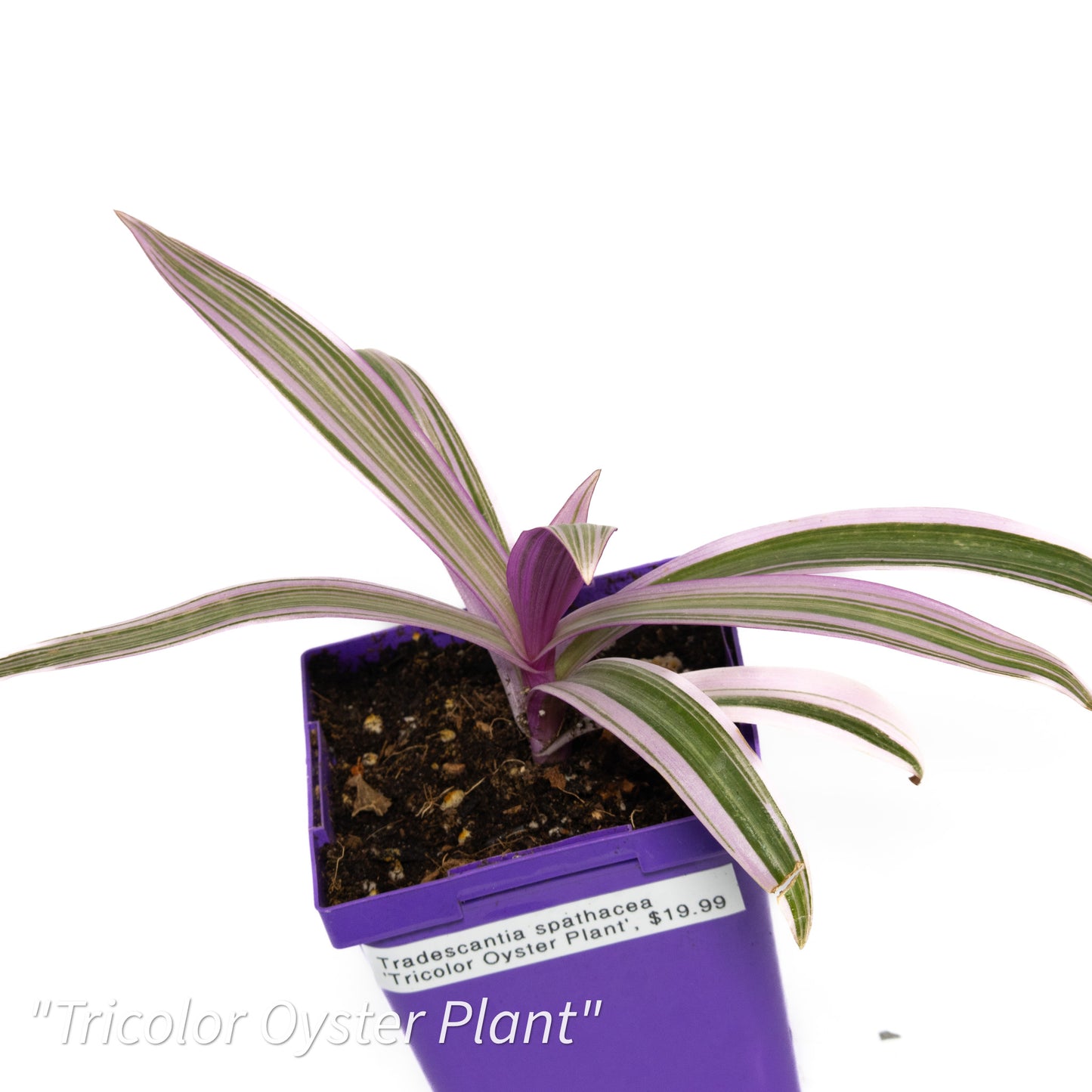Royal Python's Cove
Tradescantia spathacea ‘Tricolor Oyster Plant’
Tradescantia spathacea ‘Tricolor Oyster Plant’
Couldn't load pickup availability
Tradescantia spathacea, commonly known as the Tricolor Oyster Plant, is a vibrant, low-growing perennial known for its striking purple, pink, and green foliage. Native to tropical regions of Mexico and Central America, this plant adds a splash of color to any bioactive setup while being relatively easy to care for. Its unique color combination and growth habit make it an eye-catching addition to any terrarium or vivarium.
Care Instructions
LIGHT. Prefers bright, indirect light but can tolerate lower light conditions. In lower light, the vibrant colors may fade, and the plant may become leggy. In bioactive setups, place your Tricolor Oyster Plant near a light source to maintain the brightness of its foliage. Avoid direct sunlight, as it can scorch the delicate leaves, especially in high-humidity environments.
SOIL. Requires a well-draining soil mix that retains some moisture but doesn't become soggy. A blend of coconut coir, perlite, and orchid bark works well for this plant, providing the necessary aeration and moisture retention. In bioactive environments, this soil mix supports both the plant's growth and the activity of decomposers like springtails and isopods, which help maintain a healthy substrate.
WATERING. Keep the soil consistently moist but not waterlogged. Water when the top inch of soil begins to dry out. The plant enjoys consistently moist conditions but dislikes sitting in water, which can lead to root rot. In bioactive setups, decomposers like springtails can help manage excess moisture, but be mindful of over-watering to prevent waterlogging.
HUMIDITY. Thrives in high humidity (60% or above), making it a perfect fit for bioactive environments. The naturally humid conditions in a terrarium or vivarium are ideal for this plant, promoting healthy, vibrant foliage. Regular misting or a shallow water dish can help maintain the humidity levels required for optimal growth.
TEMPERATURE. Prefers warm temperatures between 65°F and 80°F (18°C to 27°C). It can tolerate slightly cooler conditions but should be kept away from drafts or temperatures below 50°F (10°C), as it can cause stress to the plant. A consistent, warm environment will support healthy growth and maintain the vibrant colors of its leaves.
FERTILIZATION. During the growing season (spring and summer), feed with a balanced liquid fertilizer every 4-6 weeks. In fall and winter, reduce feeding as the plant's growth slows. If you have decomposers like isopods and springtails in the substrate, their activity may naturally enrich the soil, reducing the need for frequent fertilization.
Cohabitation with Bioactive Organisms
ISOPODS. Isopods are excellent companions for Tradescantia spathacea in bioactive setups. They help break down plant debris, uneaten food, and other organic matter, keeping the substrate healthy and nutrient-rich. The decaying leaves and other plant material will be consumed by the isopods, enriching the soil and preventing the buildup of waste.
SPRINGTAILS. These tiny arthropods thrive in moist environments and will help control mold, fungi, and decaying organic material. They work efficiently in keeping the substrate healthy by feeding on fallen leaves and other decaying matter, ensuring that the roots of the Tricolor Oyster Plant remain free from mold and fungi.
Soil and Maintenance Tips
SUBSTRATE. A well-draining soil mix is essential for the Tricolor Oyster Plant. Use a blend of coconut coir, perlite, and orchid bark to provide adequate aeration and moisture retention. Adding a thin layer of activated charcoal at the bottom of the tank can help with filtration and odor control.
HUMIDITY CONTROL. Tradescantia spathacea loves humidity. In bioactive environments, a shallow water dish or regular misting will help maintain humidity levels. Make sure to monitor the humidity closely, especially in dry climates, to keep the plant thriving.
TRIMMING. The Tricolor Oyster Plant is a spreading plant, and trimming the leaves and stems periodically will help maintain its compact shape. The cuttings can be propagated in water or soil, allowing you to expand your collection or share with others.
PEST CONTROL. The Tricolor Oyster Plant is relatively pest-resistant. However, in bioactive setups, springtails and isopods can help manage pests like mealybugs and aphids by feeding on their larvae and eggs. If pests become a problem, manually remove them or address the issue with more intense pest management methods.
With its striking purple, pink, and green foliage, Tradescantia spathacea ‘Tricolor Oyster Plant’ is a beautiful addition to bioactive setups. It thrives in humid conditions, and when paired with springtails and isopods, it creates a balanced, low-maintenance ecosystem. With proper care, this plant will bring vibrant color and lush growth to your vivarium or terrarium.
Share




